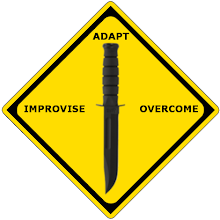A shelter can protect you from the sun, insects, wind, rain, snow, hot or cold temperatures, and enemy observation. It can give you a feeling of well-being. It can help you maintain your will to survive.
In some areas, your need for shelter may take precedence over your need for food and possibly even your need for water. For example, prolonged exposure to cold can cause excessive fatigue and weakness (exhaustion). An exhausted person may develop a "passive" outlook, thereby losing the will to survive.
The most common error in making a shelter is to make it too large. A shelter must be large enough to protect you. It must also be small enough to contain your body heat, especially in cold climates.
SURVIVAL SHELTER SITE SELECTION
When you are in a survival situation and realize that shelter is a high priority, start looking for shelter as soon as possible. As you do so, remember what you will need at the site. Two requisites are--
- It must contain material to make the type of shelter you need.
- It must be large enough and level enough for you to lie down comfortably.
When you consider these requisites, however, you cannot ignore your tactical situation or your safety.
You must also consider whether the site--
- Provides concealment from enemy observation.
- Has camouflaged escape routes.
- Is suitable for signaling, if necessary.
- Provides protection against wild animals and rocks and dead trees that might fall.
- Is free from insects, reptiles, and poisonous plants.
You must also remember the problems that could arise in your environment. For instance--
- Avoid flash flood areas in foothills.
- Avoid avalanche or rockslide areas in mountainous terrain.
- Avoid sites near bodies of water that are below the high water mark.
In some areas, the season of the year has a strong bearing on the site you select. Ideal sites for a shelter differ in winter and summer. During cold winter months you will want a site that will protect you from the cold and wind, but will have a source of fuel and water. During summer months in the same area you will want a source of water, but you will want the site to be almost insect free.
When considering shelter site selection, use the word BLISS as a guide.
B- Blend in with the surroundings.
L- Low silhouette.
I - Irregular shape.
S- Small.
S- Secluded location.
When looking for a shelter site, keep in mind the type of shelter (protection) you need. However, you must also consider--
- How much time and effort you need to build the shelter.
- If the shelter will adequately protect you from the elements (sun, wind, rain,snow).
- If you have the tools to build it. If not, can you make improvised tools?
- If you have the type and amount of materials needed to build it.
To answer these questions, you need to know how to make various types of shelters and what materials you need to make them.

 Subscribe
Subscribe